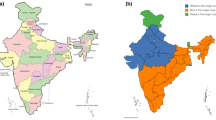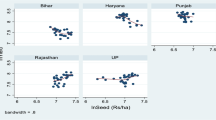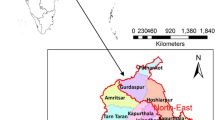Abstract
Wheat is an important agricultural crop globally. India ranks second in the world, accounting for ~ 14% of global wheat production. Wheat provides food and livelihood to a large Indian population. India would require improving its wheat yield significantly to feed the growing population. Ascertaining the wheat yield trends and their sensitivity to rising temperatures is crucial to enable sustainable wheat production, ensuring a continuous food supply. India is a diverse and vast country. One size fit to all approach seems not to offer practical and workable solutions. Therefore, it is essential to perform finer resolution analysis to identify the smallest possible administrative units (districts) to implement adaptation strategies. This study presents the spatial distribution of wheat yield trends and the impact of temperature on wheat yield across Indian districts. The key differentiating aspect of the present work is the district-level analysis compared to state-of-the-art state-level analysis in the earlier literature. We developed detailed wheat yield and temperature statistics of 50 years (1966–2015) by employing various statistical models. The present study’s critical findings over the state-of-the-art research work are: (1) Wheat yield is not improving in 69 out of 175 districts across eight major wheat-producing Indian states. 175 districts included in the analysis constitute ~ 94% of the total wheat harvested area in India, and the 69 identified districts constitute ~ 48.3% of the total wheat harvested area. The stagnation in wheat yield is prominent in Haryana, Uttar Pradesh, Maharashtra, and Punjab. (2) Mean temperature rise has negatively impacted wheat yield in 145 districts (~ 76.5% of the total wheat harvested area), causing ~ 251 kg/ha (~ 16%) yield loss in statistically significant districts. The rigorous and robust methodology in this paper ensures the validity of findings and provides higher confidence in utilizing the findings in policymaking. The method and approach used in the study pave the way for similar investigations in the other parts of the world, where wheat is an important crop.







Similar content being viewed by others
References
Akaike, H. (1974). A new look at the statistical model identification. IEEE Transactions on Automatic Control, 19(6), 716–723
Akter, N., & Islam, M. R. (2017). Heat stress effects and management in wheat. A review. Agronomy for Sustainable Development. https://doi.org/10.1007/s13593-017-0443-9
Asseng, S., Ewert, F., Martre, P., Rötter, R. P., Lobell, D. B., Cammarano, D., Kimball, B. A., Ottman, M. J., Wall, G. W., White, J. W., Reynolds, M. P., Alderman, P. D., Prasad, P. V. V., Aggarwal, P. K., Anothai, J., Basso, B., Biernath, C., Challinor, A. J., De Sanctis, G., & Zhu, Y. (2015). Rising temperatures reduce global wheat production. Nature Climate Change, 5, 143–147. https://doi.org/10.1038/nclimate2470
Asseng, S., Foster, I., & Turner, N. C. (2011). The impact of temperature on wheat yields. Global Change Biology, 17, 997–1012
Brisson, N., Gate, P., Gouache, D., Charmet, G., Oury, F.-X., & Huard, F. (2010). Why are wheat yields stagnating in Europe? A comprehensive data analysis for France. Field Crops Research, 119(1), 201–212. https://doi.org/10.1016/j.fcr.2010.07.012
Caverzan, A., Casassola, A., & Brammer, S. A. (2016). Antioxidant responses of wheat plants under stress. Genetics and Molecular Biology, 39, 1–6. https://doi.org/10.1590/1678-4685-GMB-2015-010
Challinor, A. J., Watson, J., Lobell, D. B., Howden, S. M., Smith, D. R., & Chhetri, N. (2014). A meta-analysis of crop yield under climate change and adaptation. Nature Climate Change, 4, 287–291
Chen, H. (2018). The spatial patterns in long-term temporal trends of three major crops’ yields in Japan. Plant Production Science, 21(3), 177–185. https://doi.org/10.1080/1343943X.2018.1459752
FAOSTAT. (2018). FAOSTAT Agricultural data 2018. Retrieved from http://www.fao.org/faostat/en/
Farooq, M., Wahid, A., Kobayashi, N., Fujita, D., & Basra, S. M. A. (2009). Plant drought stress: effects, mechanisms and management. Agronomy for Sustainable Development, 29, 185–212. https://doi.org/10.1051/agro:2008021
Feng, B., Liu, P., Li, G., Dong, S. T., Wang, F. H., Kong, L. A., & Zhang, J. W. (2014). Effect of heat stress on the photosynthetic characteristics in flag leaves at the grain-filling stage of different heat-resistant winter wheat varieties. Journal of Agronomy and Crop Science, 200, 143–155. https://doi.org/10.1111/jac.12045
Finger, R. (2010). Evidence of slowing yield growth—the example of swiss cereal yields. Food Policy, 35(2), 175–182. https://doi.org/10.1016/j.foodpol.2009.11.004
Hafner, S. (2003). Trends in maize, rice, and wheat yields for 188 nations over the past 40 years: A prevalence of linear growth. Agriculture, Ecosystems & Environment, 97(1–3), 275–283. https://doi.org/10.1016/S0167-8809(03)00019-7
Howden, S. M., Soussana, J.-F., Tubiello, F. N., Chhetri, N., Dunlop, M., & Meinke, H. (2007). Adapting agriculture to climate change. Proceedings of the National Academy of Sciences of the United States of America, 104, 19691–19696
IPCC. (2014). Climate Change 2014: Synthesis Report. Contribution of Working Groups I, II and III to the Fifth Assessment Report of the Intergovernmental Panel on Climate Change [Core Writing Team, R.K. Pachauri and L.A. Meyer (eds.)]. IPCC, Geneva, Switzerland, 151 pp. Retrieved from https://www.ipcc.ch/site/assets/uploads/2018/02/SYR_AR5_FINAL_full.pdf
Jones, P. D., Lister, D. H., Osborn, T. J., Harpham, C., Salmon, M., & Morice, C. P. (2012). Hemispheric and large-scale land-surface air temperature variations: An extensive revision and an update to 2010. Journal of Geophysical Research Atmospheres. https://doi.org/10.1029/2011JD017139
Kajla, M., Yadav, V. K., Khokhar, J., Singh, S., Chhokar, R. S., Meena, R. P., & Sharma, R. K. (2015). Increase in wheat production through management of abiotic stresses: A review. Journal of Applied and Natural Science, 7(2), 1070–1080. https://doi.org/10.31018/jans.v7i2.733
Lin, M., & Huybers, P. (2012). Reckoning wheat yield trends. Environmental Research Letters, 7(2), 024016. https://doi.org/10.1088/1748-9326/7/2/024016
Liu, B., Asseng, S., Müller, C., Ewert, F., Elliott, J., Lobell, D. B., Martre, P., Ruane, A. C., Wallach, D., Jones, J. W., Rosenzweig, C., Aggarwal, P. K., Alderman, P. D., Anothai, J., Basso, B., Biernath, C., Cammarano, D., Challinor, A., Deryng, D., & Zhu, Y. (2016). Similar estimates of temperature impacts on global wheat yield by three independent methods. Nature Climate Change, 6, 1130–1136. https://doi.org/10.1038/nclimate3115
Lobell, D. B. (2014). Climate change adaptation in crop production: beware of illusions. Global Food Security, 3(2), 72–76. https://doi.org/10.1016/j.gfs.2014.05.002
Lobell, D. B., & Field, C. B. (2007). Global scale climate-crop yield relationships and the impacts of recent warming. Environmental Research Letters. https://doi.org/10.1088/1748-9326/2/1/014002
Madhukar, A., Dashora, K., & Kumar, V. (2020). Investigating historical climatic impacts on wheat yield in India using a statistical modeling approach. Modeling Earth Systems and Environment. https://doi.org/10.1007/s40808-020-00932-5
Madhukar, A., Kumar, V., & Dashora, K. (2019). Spatial and temporal trends in the yields of three major crops: wheat, rice and maize in India. International Journal of Plant Production. https://doi.org/10.1007/s42106-019-00078-0
Mathur, S., Jajoo, A., Mehta, P., & Bharti, S. (2011). Analysis of elevated temperature-induced inhibition of photosystem II using chlorophyll a fluorescence induction kinetics in wheat leaves (Triticum aestivum). Plant Biology, 13, 1–6. https://doi.org/10.1111/j.1438-8677.2009.00319.x
Meza, F. J., & Silva, D. (2009). Dynamic adaptation of maize and wheat production to climate change. Climatic Change, 94, 143–156. https://doi.org/10.1007/s10584-009-9544-z
Mishra, S. B. (2014). Growth of rural non-farm employment in india: pre and post reform trends and pattern. Journal of Land and Rural Studies, 1(2), 99–112. https://doi.org/10.1177/2321024913516558
Olesen, J. E., Trnka, M., Kersebaum, K. C., Skjelvåg, A. O., Seguin, B., Peltonen-Sainio, P., Rossi, F., Kozyra, J., & Micale, F. (2011). Impacts and adaptation of European crop production systems to climate change. European Journal of Agronomy, 34, 96–112
Rao, B. B., Chowdary, P. S., Sandeep, V. M., Pramod, V. P., & Rao, V. U. M. (2015). Spatial analysis of the sensitivity of wheat yields to temperature in India. Agricultural and Forest Meteorology, 200, 192–202. https://doi.org/10.1016/j.agrformet.2014.09.023
R Development Core Team. (2018). R: A language and environment for statistical computing. Vienna, Austria: R Foundation for Statistical Computing. https://www.R-project.org/
Rathee, G. (2014). Trends of land-use change in India. In K. Sridhar & G. Wan (Eds.), Urbanization in Asia.Springer.
Ray, D. K., Ramankutty, N., Mueller, N. D., West, P. C., & Foley, J. A. (2012). Recent patterns of crop yield growth and stagnation. Nature Communication, 3, 1293. https://doi.org/10.1038/ncomms2296
Sloat, L. L., Davis, S. J., Gerber, J. S., Moore, F. C., Ray, D. K., West, P. C., & Mueller, N. D. (2020). Climate adaptation by crop migration. Nature Communication, 11, 1243. https://doi.org/10.1038/s41467-020-15076-4
Sonkar, G., Mall, R. K., Banerjee, T., Singh, N., Lakshmi Kumar, T. V., & Chand, R. (2019). Vulnerability of Indian wheat against rising temperature and aerosols. Environmental Pollution, 254, 112946. https://doi.org/10.1016/j.envpol.2019.07.114
Tanaka, A., Takahashi, K., Masutomi, Y., Hanasaki, N., Hijioka, Y., Shiogama, H., & Yamanaka, Y. (2015). Adaptation pathways of global wheat production: Importance of strategic adaptation to climate change. Scientific Reports, 5, 14312. https://doi.org/10.1038/srep14312
Tilman, D., Balzer, C., Hill, J., & Befort, B. L. (2011). Global food demand and the sustainable intensification of agriculture. Proceedings of the National Academy of Sciences, 108(50), 20260–20264. https://doi.org/10.1073/pnas.1116437108
United Nations Population Division. (2019). World Population Prospects the 2019 revision. Population Division, Department of Economic and Social Affairs, United Nations, New York. Retrieved from https://population.un.org/wpp/Publications/Files/WPP2019_Highlights.pdf
Zaveri, E. B., & Lobell, D. (2019). The role of irrigation in changing wheat yields and heat sensitivity in India. Nature Communication, 10, 4144. https://doi.org/10.1038/s41467-019-12183-9
Zhao, C., Liu, B., Piao, S., Wang, X., Lobell, D. B., Huang, Y., Huang, M., Yao, Y., Bassu, S., Ciais, P., Durand, J.-L., Elliott, J., Ewert, F., Janssens, I. A., Li, T., Lin, E., Liu, Q., Martre, P., Müller, C., & Asseng, S. (2017). Temperature increase reduces global yields of major crops in four independent estimates. Proceedings of the National Academy of Sciences of the United States of America, 114, 9326–9331. https://doi.org/10.1073/pnas.1701762114
Acknowledgements
Anand Madhukar sincerely thank the Indian Institute of Technology Delhi (IIT Delhi) India for providing a research fellowship. Authors declare no conflict of interest or finance.
Funding
Anand Madhukar sincerely thank the Indian Institute of Technology Delhi (IIT Delhi) India for providing a research fellowship.
Author information
Authors and Affiliations
Contributions
Conceptualization, Methodology, Software, Formal analysis and investigation, Data Curation, Writing—Original draft preparation, Writing—review and editing, Visualization: [AM]; Supervision, Funding acquisition: [KD]; Validation, Supervision, Funding acquisition: [VK].
Corresponding author
Ethics declarations
Conflict of interest
Authors declare that they have no conflict of interest or finance.
Supplementary Information
Below is the link to the electronic supplementary material.
42106_2021_140_MOESM1_ESM.pdf
Supplementary file1 Supplementary Information: Supplementary information includes Supplementary Fig. S1 (showing wheat yield trends for Indian districts), Supplementary Table S1 (showing the best-fit models, the coefficients of determination, and the nature of yield trends for Indian districts), Supplementary Fig. S2 (showing the impact of mean temperature on wheat yield in Indian districts), Supplementary Table S2 (showing the regression results for the impact of mean temperature on wheat yield for Indian districts), Supplementary Fig. S3 (showing the impact of maximum temperature on wheat yield in Indian districts), Supplementary Table S3 (showing the regression results for the impact of maximum temperature on wheat yield for Indian districts), Supplementary Fig. S4 (showing the impact of minimum temperature on wheat yield in Indian districts), Supplementary Table S4 (showing the regression results for the impact of minimum temperature on wheat yield for Indian districts), and Supplementary Table S5 (showing the irrigated areas for Indian districts). (PDF 1602 kb)
Rights and permissions
About this article
Cite this article
Madhukar, A., Dashora, K. & Kumar, V. Spatial Analysis of Yield Trends and Impact of Temperature for Wheat Crop Across Indian Districts. Int. J. Plant Prod. 15, 325–335 (2021). https://doi.org/10.1007/s42106-021-00140-w
Received:
Accepted:
Published:
Issue Date:
DOI: https://doi.org/10.1007/s42106-021-00140-w




